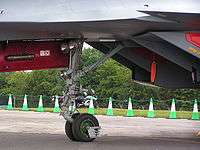Strut

A strut is a structural component designed to resist longitudinal compression. Struts provide outwards-facing support in their lengthwise direction, which can be used to keep two other components separate, performing the opposite function of a tie. They are commonly used in architecture and engineering.
Automobiles
As components of an automobile chassis, struts can be passive braces to reinforce the chassis and/or body, or active components of the suspension. An automotive suspension strut combines the primary function of a shock absorber (as a damper), with the ability to support sideways loads not along its axis of compression, somewhat similar to a sliding pillar suspension, thus eliminating the need for an upper suspension arm. This means that a strut must have a more rugged design, with mounting points near its middle for attachment of such loads.
The most common form of strut in an automobile is the MacPherson strut. MacPherson struts are often purchased by the automakers in sets of four completed sub-assemblies: These can be mounted on the car bodies as part of the manufacturers' own assembly operations. The MacPherson strut combines a shock absorber and a spring in a single unit, by means of which each wheel is attached to the car body.
Transportation-related struts are used in "load bearing" applications ranging from both highway and off-road suspensions to automobile hood and hatch window supports to aircraft wing supports. In vehicle suspension systems, struts are most commonly an assembly of coil-over spring and shock absorber. Other variants to using a coil-over spring as the compressible load bearer include support via pressurized nitrogen gas acting as the spring, and rigid (hard tail) support which provides neither longitudinal compression/extension nor damping.
Strut failure
Signs of strut failure include a popping or clicking noise when the steering wheel of the vehicle is turned, especially when the vehicle is not in motion. This noise is caused by a worn out bearing. Most strut failure is gradual, and becomes evident as a more "trampoline"-like ride, rough travel over bumps, and tire noise/ vibrations. This wear affects all of the strut components in a feedback loop: the more worn out the shock absorbers become, the more worn out the spring will become, the more worn out the mount will become, and the more this will affect the shock absorbers. A tendency for the front of the vehicle to "nose dive" when applying the brakes and to rear upwards ("squatting") when accelerating are other signs of strut failure, as is difficulty handling the vehicle generally. These symptoms will only tend to worsen until the struts are replaced with new components (struts cannot be repaired when worn out, but must be removed entirely). Many strut "replacements" on non-commercial vehicles are in fact only replacements of the shock absorber and not the other components.
Vehicle handling is one of the easiest aspects of a potential new car purchase for a buyer to assess without professional assistance. A car which nose dives when stopped suddenly, squats when rapidly accelerated, or tends to "roll" when going around curves in the roadway are all signs that the vehicle will likely require strut replacement in the near future, regardless of other aspects of the vehicle such as the apparent condition of its body or its interior.
Architecture and construction
In piping, struts restrain movement of a component in one direction while allowing movement or contraction in another direction.[1]
Strut channel made from steel, aluminium, or fibre-reinforced plastic is used heavily in the building industry and is often used in the support of cable trays and other forms of cable management, and pipes support systems.
Strut is a common name in timber framing for a support or brace of scantlings lighter than a post. Frequently struts are found in roof framing from either a tie beam or a king post to a principal rafter. Struts may be vertically plumb or leaning (then called canted, raking, or angled) and may be straight or curved. In the U.K., strut is generally used in a sense of a lighter duty piece: a king post carries a ridge beam but a king strut does not, a queen post carries a plate but a queen strut does not, a crown post carries a crown plate but a crown strut does not.
Strutting or blocking between floor joists adds strength to the floor system.
Aircraft
Bracing struts and wires of many kinds were extensively used in early aircraft to stiffen and strengthen, and sometimes even to form, the main functional airframe. Throughout the 1920s and 1930s they fell out of use in favour of the low-drag cantilever construction. Most aircraft bracing struts are principally loaded in compression, with wires taking the tension loads. Lift struts came into increasing use during the changeover period and remain in use on smaller aircraft today where ultimate performance is not an issue. Typically they are applied to a high-wing monoplane and act in tension during flight.
Struts have also been widely used for purely structural reasons to attach engines, landing gear and other loads. The oil-sprung legs of retractable landing gear are still called Oleo struts.
Human anatomy
Part of the functionality of the clavicle is to serve as a strut between the scapula and sternum, resisting forces that would otherwise bring the upper limb close to the thorax. Keeping the upper limb away from the thorax is vital for its range of motion. Complete lack of clavicles may be seen in cleidocranial dysostosis, and the abnormal proximity of the shoulders to the median plane exemplifies the clavicles' importance as struts.
Gallery
 ORI Strut, Off-road application of strut
ORI Strut, Off-road application of strut- Strut bar
- Compression strut on Piper Pawnee (low-wing aircraft)
 Tension strut on Shorts 360 (high-wing aircraft)
Tension strut on Shorts 360 (high-wing aircraft) MacPherson Strut suspension
MacPherson Strut suspension Nosewheel oleo strut on Su-30MKI aircraft
Nosewheel oleo strut on Su-30MKI aircraft
See also
References
- ↑ Sway Strut Assemblies Piping Technology & Products, (retrieved March 2012)